Jakarta, MINA – Indonesia’s national mosque, Istiqlal Mosque, has undergone an environmentally-friendly retrofit that has seen it significantly lower its carbon footprint while also becoming the first place of worship in the world to be awarded final certification under the EDGE system.
The Istiqlal Mosque Management Agency (BPMI), Green Building Council of Indonesia (GBC Indonesia) and Indonesia’s Ministry of Public Work and Housing have partnered with IFC, a member of the World Bank Group, to redevelop the mosque to add environmentally friendly features that will boost water and energy efficiency of the iconic building.
This achievement was marked by the handover ceremony for the EDGE Final Certificate in the VVIP Room of the Istiqlal Mosque, Central Jakarta on Wednesday.
Prof. Nasaruddin Umar, High Priest of the Istiqlal Mosque, said that the work undertaken at the Istiqlal Mosque is not only seen as helping in the fight against climate change but as setting an example that will encourage uptake of green design practices in Indonesia and elsewhere.
Also Read: Peaceful Muharram: 2 Million Eid Gift Packages to Orphans and Persons with Disabilities
“Muslims feel a strong imperative to for mosques to go green to enhance the quality of their worship and honour the leadership of the Rasulullah SAW who insisted on the need to protect the environment. Thus, redeveloping the mosque to make it a centre of enlightenment for environmental protection has been one of our priorities,” he said.
He added, “We are very honoured that it has become the world’s first mosque to be awarded final certification from EDGE. This remarkable achievement is clear evidence of our commitment to promoting conservation efforts both at the Istiqlal Mosque and across the country.
By using reflective paint for the roof and external walls, energy-saving lighting in internal and external spaces, smart energy meters and solar photovoltaics that cover more than 13 percent of its electricity consumption, it’s expected the Istiqlal Mosque will see an energy saving of 23 percent.
With the use of low-flow faucets, grey water treatment and recycling and other efficiency measures, overall water consumption will be reduced by as much as 36 percent.
Also Read: Responsible Gadget Use Strengthens Healthy Digital Literacy
“This project is a great example of what can be achieved if we work together in seeking to counter the climate crisis, which remains one of the greatest challenges of our time,” said Azam Khan, Country Manager for Indonesia and Timor-Leste.
“Climate change is threatening lives and livelihoods and is slowing progress on poverty reduction while climate-related disasters are becoming more frequent, including in Indonesia. There are also opportunities to take direct action and the redevelopment of the Istiqlal Mosque shows that investing in climate resilient infrastructure, including green buildings, can make a measurable difference.”
Indonesia is home to some of fastest-growing cities in Asia, with Jakarta on track to have a population that surpasses that of Tokyo’s by 2030, making it the world’s biggest city.
At the same time, rapid urbanization and growth likes this presents major environmental challenges, further underscoring the need for ambitious climate action.
Also Read: KMP Tunu Pratama Jaya Sinks, Marking Another Tragedy in the Bali Strait
“We are pleased to be part of this pioneering initiative. The steps taken by Masjid Istiqlal, representing religious and heritage buildings, will not only improve energy efficiency but will also serve as viable proof that green building is possible for any type of building, including new buildings and existing buildings,” said Diana Kusumastuti, MT. Director General for Human Settlements with the Ministry of Public Work and Housing.
She said, encouraging the development of environmentally friendly infrastructure, settlements, housing, and buildings is critical to helping realize the government’s commitment to reducing emissions.
In addition to the final EDGE certification, the Istiqlal Mosque is also undergoing a GREENSHIP assessment from GBC Indonesia and has also received the Ecomasjid predicate, initiated by the Council of Indonesian Ulama.
“GBC Indonesia applauds Istiqlal Mosque’s remarkable achievement to be the first religious building to be awarded EDGE final certification,” said Iwan Prijanto, Chairperson of GBC Indonesia.
Also Read: Prominent Legal Expert Abdul Rahman Saleh Passes Away
“The Istiqlal Mosque was built as a symbol of greatness of Islamic society in Indonesia, and is representative of their magnificent respect for Allah SWT, society, and nature. We look forward to seeing this initiative replicated as part of collective efforts protect the environment and contribute to a more sustainable future,” he added.
EDGE (Excellence in Design for Greater Efficiencies) is a green building certification system developed by IFC.
It provides technical solutions for adapting construction projects to green building standards while generating positive environmental and financial outcomes.
To date, EDGE has certified more than 1.6 million square meters of building space in Indonesia, cutting carbon emissions by as much as of 48,000 tons per year, which is equivalent to planting around 800,000 trees.
Also Read: A Joyous Moment for Indonesian Volleyball: Megawati Hangestri Ties the Knot
About Istiqlal
Istiqlal Mosque is located in the capital city of Jakarta. It is the largest mosque in Southeast Asia. It was built during the era of President Soekarno on August 24, 1961, and was inaugurated by President Soeharto on February 22, 1978.
The Istiqlal Mosque was built as a manifestation of gratitude for the blessings of Indonesian independence, thus named “Istiqlal”, an Arabic word for “Independence”.
Istiqlal Mosque is majestically and firmly standing, not only being the pride of Muslims in Indonesia but also symbolizes the greatness of the Indonesian nation, where various ethnic groups, languages, and religions live in harmony.
Also Read: Indonesia’s BPOM Seals Deal with Sudan, Paving Way for Herbal Exports
The mosque was designed by a Christian architect, Friedriech Silaban. It can accommodate approximately 200,000 worshipers.
This mosque stands on the land of the former Wilhelmina Park and the Dutch Colonial fort, located between the National Monument and Banteng Square, and is next to Cathedral Church.(L/R1/RE1)
Mi’raj News Agency (MINA)
Also Read: Maemuna Center Joins Indonesian Women’s National Movement to Boycott Pro-Israel Products





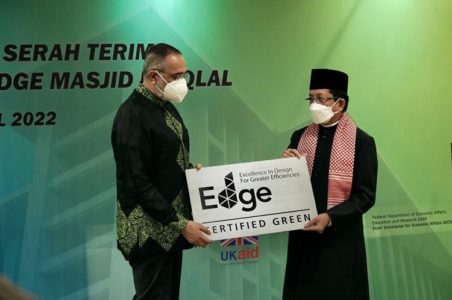










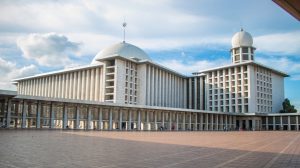
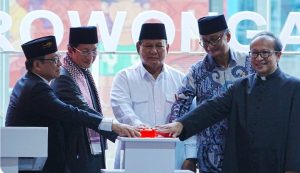

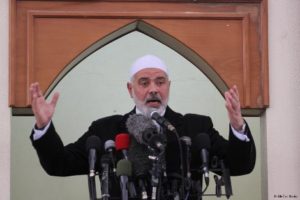
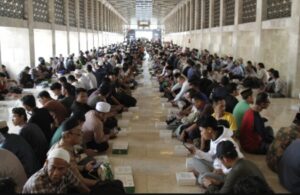






![MUI Chairman for Foreign Relations and International Cooperation, Sudarnoto Abdul Hakim (center) at the One Million Women for Gaza Press Conference entitled "Women Boycott Pro-Israel Products" held at the Swiss-Belinn Cawang Hotel, East Jakarta, Thursday (3/7/2025). [Photo: Arina/MINA]](https://en.minanews.net/wp-content/uploads/2025/07/20250703_144042-scaled-1-300x225.jpg)
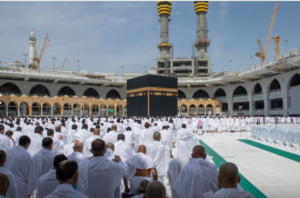




 Mina Indonesia
Mina Indonesia Mina Arabic
Mina Arabic